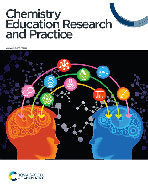Effect of visual anthropomorphic stories on students’ understanding of the particulate nature of matter and anthropomorphic discourse†
Abstract
This study investigated the effect of visual anthropomorphic stories on students’ understanding of the particulate nature of matter and their level of anthropomorphic discourse. This study employed a quasi-experimental research design with pretest and posttest control groups. Science activities supported by visual anthropomorphic stories were conducted in the experimental group, and the 2018–2019 science curriculum was implemented in the control group. Two measurement tools, which included a ‘two-tier diagnostic test for the particulate nature of matter’ and an ‘anthropomorphic discourse usage-level test for the atomic concept’, were used. Consequently, this study showed that the anthropomorphic discourse scores were statistically significant in favor of the students in the experimental group, while their scientific explanation scores were statistically significant in favor of students in the control group. That is, the science activities supported by visual anthropomorphic stories further developed students' anthropomorphic discourse in the experimental group but could not sufficiently develop their scientific explanations. Additionally, this study showed that the scores of the ‘positive tendency’ taxonomy on the particulate nature of matter for the students in both groups were close to each other, but their scores of the ‘negative tendency’ taxonomy were statistically significant differences in favour of the control group. Namely, science activities supported by visual anthropomorphic stories could help students in well understanding concepts of the particulate nature of matter.


 Please wait while we load your content...
Please wait while we load your content...